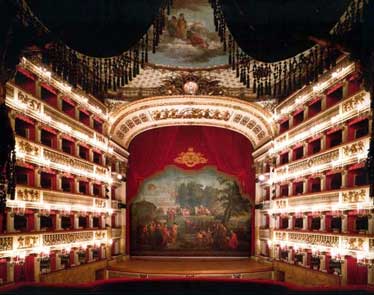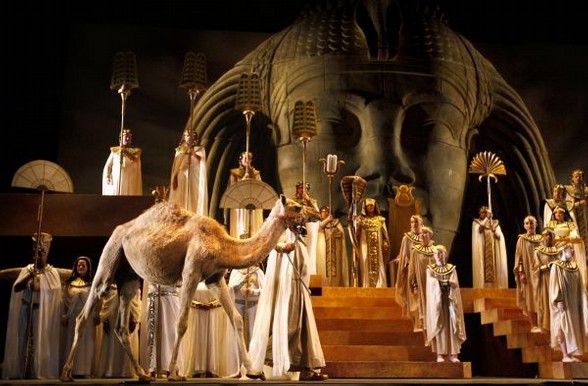Italian Opera
Musical drama was already in place during the 12th century, opera came to being as a musical art form in the 17th century, in Florence. It appeared with a society of scholars, philosophers, and musicians called "Camerata".
The early composers named their work dramma per musica, and Greek subjects were used for the plots.
Jacopo Peri’s Eurydice (1600) is the first "opera". Stefano Landi defined Roman opera with a libretto by Giulio Rospigliosi (who later became Pope Clement IX). His rendition of Eurydice had comic scenes, which were unheard of in the past.

Baroque opera reached its peak in Venice with Claudio Monteverdi (born 1567.) The first opera house opened in that city in 1637 and a musical format, which began as entertainment for the nobility, was now accessible to the general publc. By the year 1700 sixteen theatres were built in Venice alone. The Bel Canto and Buffo styles are also attributed to Monteverdi. The next generation of Venetian composers gave less importance to the chorus and more attention to the soloists.
The Neapolitan Alessandro Scarlatti (born 1660) was at the head of the Neapolitan school. Scarlatti was incremental in establishing the Opera Seria and in perfecting the three-part overture. His son, Domenico Scarlatti was also a composer and an accomplished musician.
Traditionally comedy took the form of interludes, or Intermezzi, that were performed between the acts of the opera seria. Comic opera took front stage in the early 1800s with Giovanni Battista Pergolese with La Serva Padrona, Giovanni Paisiello with Il Barbiere di Seviglia, and Domenico Cimarosa with Il Matrimonio Segreto. The characters and the plots come from directly from the exhuberant commedia dell’arte style and their popularity overshadowed the "serious" operas based on the Greek tragedies.
Amadeo Mozart’s finest comedies were written by the north Italian librettist Lorenzo da Ponte (1800) whose masterpieces include Le Nozze di Figaro, Don Giovanni, and Cosi Fan Tutte. The operatic style evolved as it spread throughout Europe whereas Italian opera stayed focused on the mastery of the voice and on melody.
Donizetti and Bellini are both stars of melody and comic opera but Rossini is master in the art, and the most entertaining. Arguably the best performance of his Barbiere di Seviglia (1816), with the famous “Figaro, Figaro” passage, was dircted by Dario Fo in Barcelona.
The composer Giuseppe Verdi (born 1813) dominated the stage with his lyrical, dramatic style faithful to the Italian school. The most famous of his operas are Rigoletto, based on Victor Hugo’s novel “The King’s Jestor”. La Traviata was taken from Alexander Duma’s play Camille and Aida in 1871. Three years later he wrote a Requiem to honor his friend, the writer Alessandro Manzoni. Verdi was nominated a senator and offered a marquisate, which he refused.
Giaccomo Puccini’s first successes were Manon Lescaut and La Boheme. His next opera, Madame Butterfly, was not a success until he revised it. His last opera was The Turnadot, in 1926.
Verdi
Aida, an Ethiopian princess, is captured by the Egyptian army and is put into slavery.
Radamès, military commander, struggles to choose between his love for her and his loyalty to the Pharaoh.
Radamès is loved by the Pharaoh's daughter Amneris.
